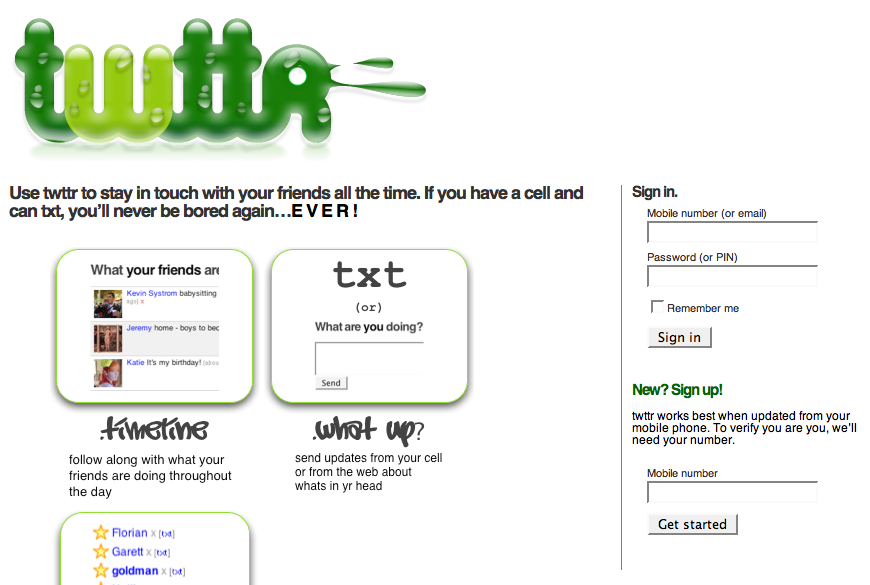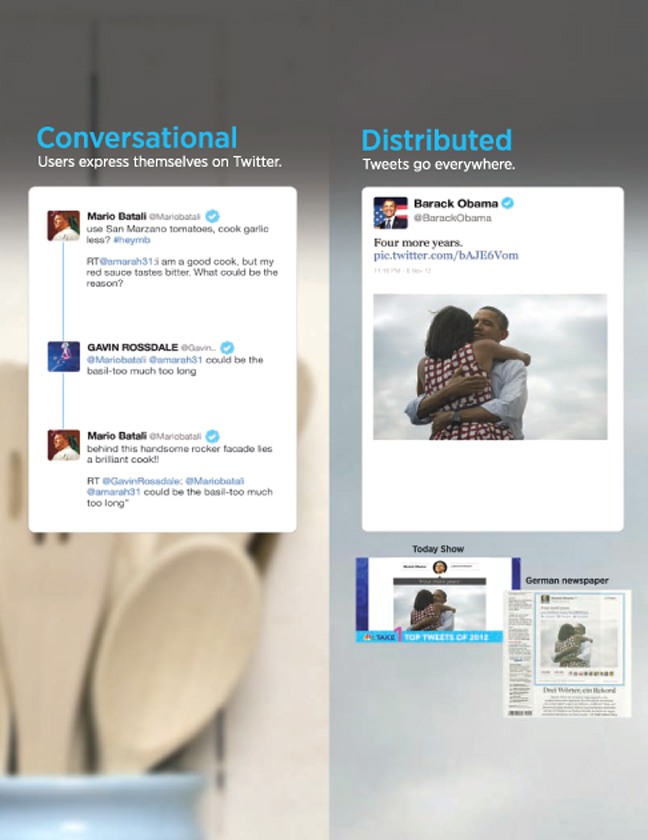

Twitter has evolved to become one of the most sophisticated hypertext writing spaces in social media. The initial Twitter home page, Twittr, instructed users, "txt / or / What are you doing?" followed by a short single-line form field. Below that read ".what up" in a bold handwriting font, with instructions to "send updates from your cell or from the web about whats in yr head" (S. Bennett, 2014). Upon its release in 2006, Twitter was a space for status updates and personal thoughts, not necessarily conversation. It certainly was not considered to be the public, real-time, distributed conversational (Costolo, 2013) multimodal communication space it has become, blending alphabetic text, hyperlinks, images, and videos.
What's happening?

Twitter's home page in 2006.
As of this writing, users are confronted with three different form fields with three different prompts: "Tweet to @username" when tweeting from a user's feed; "What's happening?" at the top of one's own feed; or "Compose new tweet" after clicking on the tweet button next to one's avatar. But, how does one know how to "compose a tweet"? And who is going to read the tweet? There are no contextual clues, no hints toward possible grammars or audiences. Liza Potts and Dave Jones (2011) have shown how writers using social media must navigate complex, often disruptive writing spaces in order to successfully access and move information. Like most Web 2.0 writing environments, Twitter requires "users to learn new vocabularies, recognize the characteristics of new writing spaces that contain multiple symbiotic genres, reconceive of the relationships among multiple applications, and be able to transfer knowledge of functionality from one application to the next" (Wolff, Fitzpatrick, & Youssef, 2009).
What's happening?

The second of two pages of images showcasing Twitter's dynamic community from their Securities and Exchange Commission filing, October 2013.
Twitter's simple layout and lack of communication features resulted in users attempting to create ways to build and transform the space as well as create community-specific discourses to compose tweets of varying nuance and complexity. Unlike in MOOs, IRCs, Instant Message chats, or text messages—four communication spaces Twitter remediates (Bolter, 2001)—there was no readily available way to indicate a conversation among two or more users or for one user to directly contact another. That changed on November 2, 2006, when Robert S. Anderson became the first to implement the @ symbol (albeit with a space between the @ and the username) to signify a public conversation with another user. By the end of the month, Neil Crosby had removed the space and the @reply was born. Twitter adopted the feature officially in May 2007.
Hashtags and retweets have similar histories. Writers on Twitter wanted a way to classify tweets on a particular topic, similar to how Flickr users were able to tag photographs, to enhance "contextualization, content filtering and exploratory serendipity within Twitter" (Messina, 2007). Inspired by the use of the # in former social networking site Jaiku, on August 23, 2007, Chris Messina proposed using # to indicate a group or a "channel tag" (Messina, 2007). Steve Boyd later coined the use of a # followed by a keyword, a "hash tag." Twitter officially adopted hashtags in July 2009 (Seward, 2013). Michele Zappavigna's (2011) linguistic study of 45,000 tweets archived within 24 hours of the 2008 presidential election illustrated how Twitter writers employed hashtags as functional markers that "encode both the structure and the meaning of a particular unit" (p. 792). John Jones's (2014) study of the #healthcare hashtag suggested writers are sophisticated readers of both their own audience and possible existing networks and are able to leverage hashtags to try to influence both.
It didn't take long for writers to create a new way to use hashtags:
Example Corpus Tweet
"Bruce Springsteen concert! :) #tooexcited #ahhhhhh"
Here, hashtags are not classifiers; rather they are expressions that reflect the emotional state of the author. Alice R. Daer, Rebecca Hoffman, and Seth Goodman (2014) labeled these kinds of hashtags "metacommunicative tags." Their study of metacommunicative tags across five social networking sites, including Twitter, shows how writers are continuing to transform existing site structures and functions to fit their own rhetorical goals.
Eric Rice created retweets on April 7, 2007, using the phrase "ReTweet:" followed by the username, as a way to forward on a tweet that maintains original authorship. In 2007, users had to copy the full tweet they wanted to retweet and paste it into a new form field after they typed ReTweet (and later RT). In July 2009, Twitter officially adopted the retweet (Seward, 2013). danah boyd, Scott Golder, and Gilad Lotan's (2010) study of retweets showed how writers adapt their application of the retweet to fit within the constraints of the system and maintain original authorship. For example, when writers need to fit the retweet within the 140-character limit, they have used MT, or modified tweet, in the place of RT, to indicate they have removed some words but have maintained the original tweet's meaning.
Danielle Nicole DeVoss and James E. Porter's (2006) observation about Napster is informative when considering Twitter: it has created "an emergent and ill-understood view of writing as weaving digital media for distribution across networked spaces for various audiences engaged in different types of reading" (p. 179). For DeVoss and Porter (2006), Napster represented a revolutionary change in the "fundamental rhetoric of ethics of delivery and distribution—the very reason why people write and share their writing in the first place" (p. 180). Hashtags, retweets, and @replies emerged with a new mode of information delivery, just as punctuation became necessary with the transition from oral to written delivery. Early users of Twitter were finding ways to hack the writing space to fit their composing needs and "craft creative, meaty, and to-the-point messages that attract other people's attention" (Silver, 2009). David Silver (2009), building on Clifford Geertz's (1973) theory of "thick" observations, has described the rhetorical challenges and opportunities afforded by and composing a thick instead of a thin tweet. Thin tweets have only one layer of information—"My cat had chicken for dinner" or "Today I'm going to vote"—basically the kind of tweet Twitter suggested when it was first released. While over time thin tweets "can actually foster the sustainability of public information ecologies" (McNely, 2010, p. 6), thick tweets have multiple layers of information that engage readers at the moment of reading:
Example Corpus Tweet
Backstage with @StevieVanZandt and @MVZaGoGo getting ready for the big show! Springsteen about to crush jersey! http://t.co/0Zit6R5M
In the above tweet there are four layers of information: the ideas in the tweet, two linked usernames, and a Twitpic. The author might have used a # in front of "Springsteen" to add a fifth level. Doing so would affiliate the tweet with the thousands of others of tweets per minute that also contain #Springsteen. By not including the hashtag, the author is composing for a much smaller potential audience.
Ultimately, writers on Twitter, like the author of the above tweet, make conceptual and rhetorical choices by taking into consideration the constraints of the medium, the goals of the tweet, the composition of the tweet, the real and imagined audiences (Marwick & boyd, 2011), and the technologies used to deliver the message.
Track 1: Introduction
Track 3: Fans/Readers/Writers